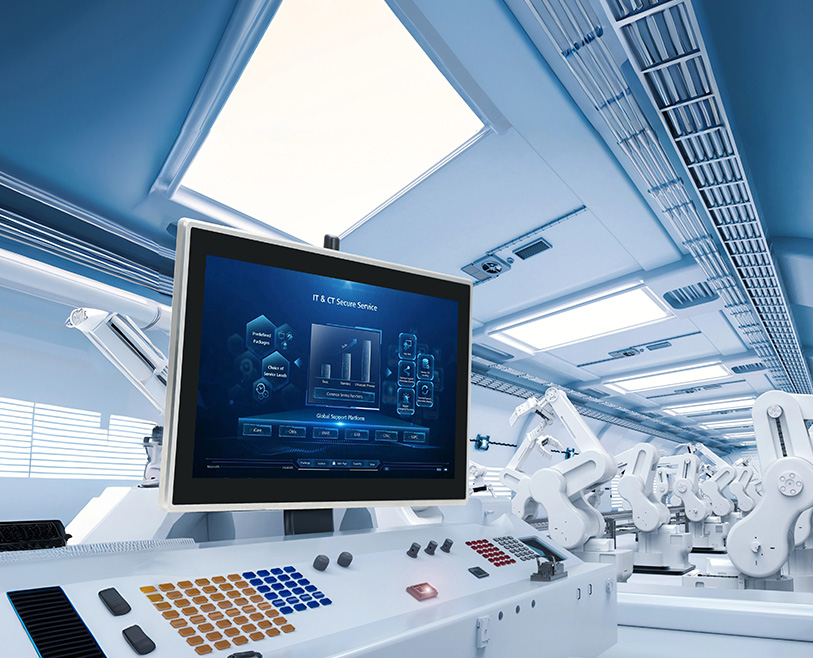In the evolution of factory control systems, two options have emerged as primary choices for operators: Industrial HMI Displays and traditional panels. While traditional panels—with their array of physical buttons, dials, and analog gauges—have long been the backbone of manufacturing control, Industrial HMI Displays (Human-Machine Interfaces) are rapidly gaining ground with their digital flexibility and integration capabilities. For factory managers, the decision between the two isn’t just about technology—it’s about selecting a system that aligns with production goals, operator workflows, and long-term efficiency. This guide compares Industrial HMI Displays and traditional panels across critical factors like functionality, cost, adaptability, and user experience, helping you determine which solution best fits your factory’s needs.

Core Differences in Functionality and Usability
The most impactful distinctions between Industrial HMI Displays and traditional panels lie in how they enable control and data interaction:
1. Data Visualization and Accessibility
Industrial HMI Displays: These digital systems excel at consolidating real-time data into intuitive visuals. Operators can view production metrics, machine statuses, and error alerts on a single screen, with customizable dashboards that highlight critical information (e.g., downtime reasons, yield rates). Advanced models even support trend graphs and historical data comparisons, empowering operators to identify patterns quickly.
Traditional Panels: Physical panels are limited to individual gauges and LED indicators, making it hard to connect data points. For example, checking a machine’s temperature alongside its output rate might require glancing at two separate dials, slowing decision-making.
2. Control Flexibility
Industrial HMI Displays: Offer dynamic, software-driven control. Operators can adjust settings (e.g., speed, pressure) via touch inputs, save preset configurations for recurring tasks, and even automate sequences with a few taps. This flexibility is invaluable for factories with varied production runs (e.g., switching between product models).
Traditional Panels: Relied on fixed physical controls. Changing a setting often means adjusting a specific dial or pressing a dedicated button, with little room for customization. Adapting to new production requirements may require rewiring or replacing components— a time-consuming process.
3. Operator Learning Curve
Industrial HMI Displays: While initial training is needed to navigate digital menus, most operators adapt quickly to intuitive touch interfaces (similar to smartphones). Tutorials and on-screen prompts can be built into the software, reducing training time for new staff.
Traditional Panels: Require memorization of button functions and gauge readings, which can be overwhelming for new operators. Mistakes (e.g., pressing the wrong button) are more common, especially in high-stress situations.
Cost Comparison: Initial Investment vs. Long-Term Value
Budget considerations play a major role in the decision, but it’s essential to look beyond upfront costs:
1. Initial Purchase and Installation
Industrial HMI Displays: Have a higher upfront cost, ranging from 500to 5,000+ depending on size and features (e.g., ruggedness, connectivity). Installation may also cost more due to software setup and integration with existing systems (e.g., PLCs, MES).
Traditional Panels: Typically cost less initially (200 to1,500) and are simpler to install, as they require basic wiring to connect to machinery.
2. Maintenance and Upkeep
Industrial HMI Displays: Require periodic software updates (often free) to fix bugs or add features. Hardware maintenance is minimal, though screen replacements (if damaged) can be costly. However, their digital nature reduces wear and tear from physical button presses.
Traditional Panels: Physical components (e.g., buttons, potentiometers) wear out over time and need frequent replacement—adding up in parts and labor costs. Rewiring for upgrades also incurs ongoing expenses.
3. Scalability and Future-Proofing
Industrial HMI Displays: Easily scale with factory growth. Adding new machines or production lines often involves updating software settings rather than replacing hardware. They also integrate seamlessly with smart factory technologies (e.g., IoT sensors, AI-driven analytics), ensuring long-term relevance.
Traditional Panels: Lack scalability. Expanding production may require entirely new panels, and they struggle to connect with modern digital systems—risking obsolescence as factories adopt Industry 4.0 practices.
Ideal Use Cases for Each Solution
Neither option is universally better—their suitability depends on your factory’s specific needs:
1. When to Choose Industrial HMI Displays
High-variability production: Factories that switch between products or recipes (e.g., food processing, electronics assembly) benefit from customizable presets and quick adjustments.
Data-driven operations: Facilities focused on continuous improvement need the real-time analytics and trend tracking that HMI displays provide.
Large or complex systems: Factories with multiple interconnected machines (e.g., automotive assembly lines) rely on HMI displays to centralize control and reduce operator workload.
2. When to Stick with Traditional Panels
Simple, repetitive tasks: Small factories with single-machine operations (e.g., a standalone packaging line) may not need the complexity of HMI displays.
Low-budget constraints: For facilities with limited upfront capital and minimal growth plans, traditional panels offer a cost-effective short-term solution.
Harsh environments with extreme constraints: In rare cases—such as facilities with constant vibration or exposure to chemicals that damage touchscreens—rugged traditional panels may be more durable (though many HMI displays now offer IP67+ ratings).
FAQs About Industrial HMI Displays and Traditional Panels
Q1: Can Industrial HMI Displays replace all traditional panels in a factory?
A1: In most cases, yes—especially with modern ruggedized HMI models. However, some factories keep a few traditional panels as backups for critical emergency controls (e.g., emergency stop buttons).
Q2: Are Industrial HMI Displays more prone to downtime due to software issues?
A2: No—with proper updates and backups, software-related downtime is rare. In fact, HMI displays often reduce downtime by enabling faster troubleshooting through error alerts and diagnostics.
Q3: How long does it take to transition from traditional panels to Industrial HMI Displays?
A3: Installation and integration typically take 1–2 weeks for a single machine, with operator training adding another 2–3 days. Factories can transition gradually, replacing panels one area at a time.
Q4: Do Industrial HMI Displays require specialized IT support?
A4: Basic operation and maintenance don’t—most suppliers provide user-friendly software with intuitive interfaces. For advanced integration (e.g., connecting to IoT systems), occasional IT support may be helpful but isn’t mandatory.
The choice between Industrial HMI Displays and traditional panels hinges on your factory’s goals: if you prioritize flexibility, data access, and scalability, HMI displays are the clear long-term investment. For simple, low-variability operations with tight budgets, traditional panels may suffice—though they risk becoming outdated as manufacturing evolves.
If you’re unsure which solution fits your factory’s needs (e.g., need help calculating long-term ROI for HMI displays, or want to assess your current operations for compatibility), fill out the form on our website. Our industrial automation experts will evaluate your production processes, budget, and growth plans to recommend the optimal control solution—helping you make a decision that aligns with your operational goals.

